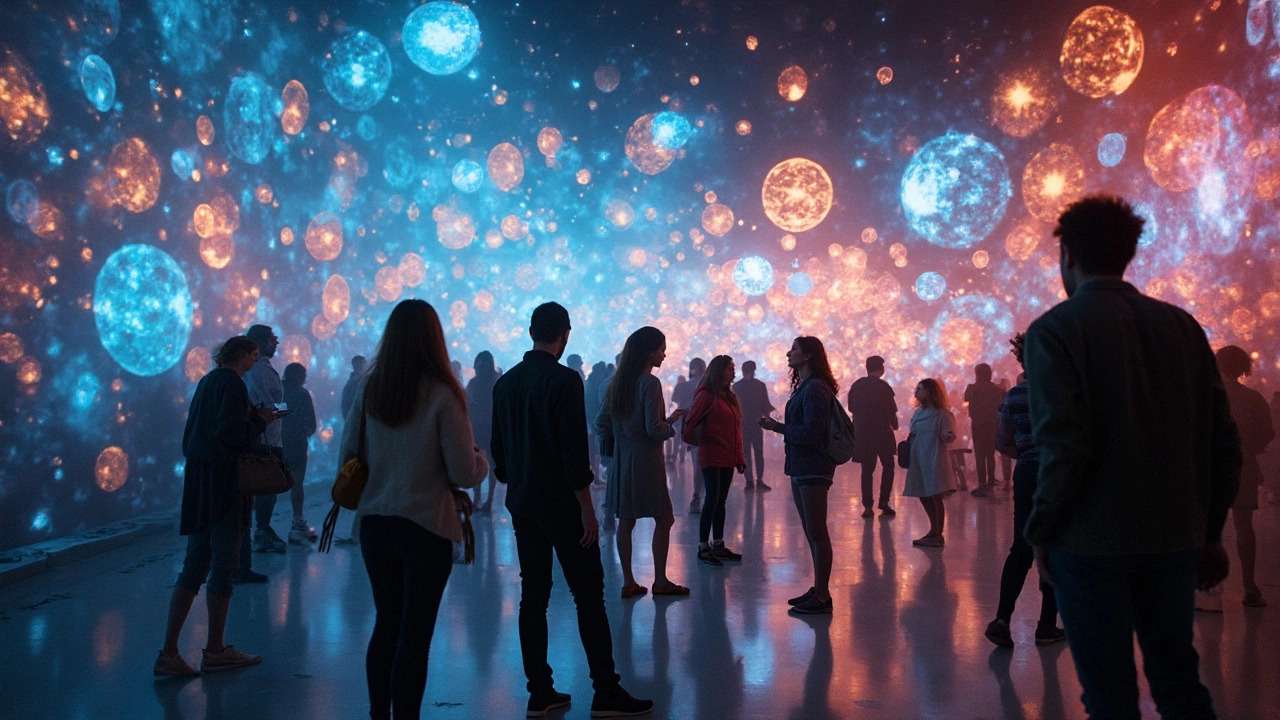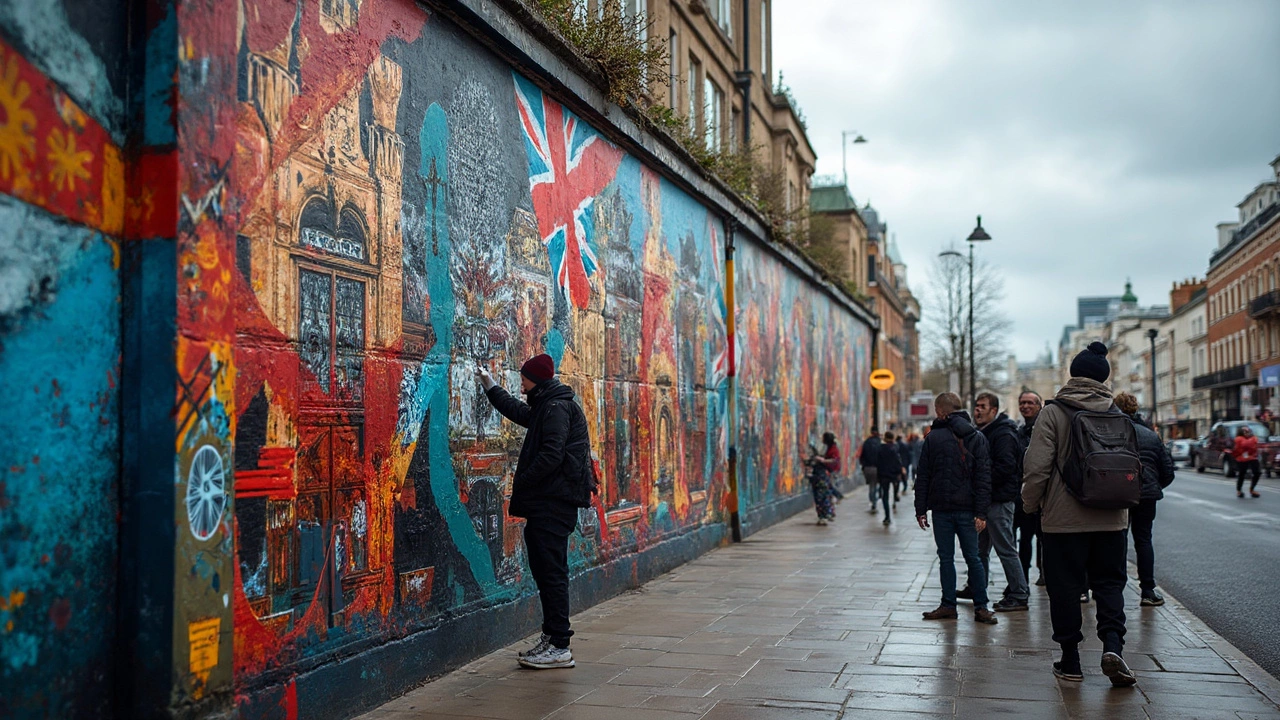Curious about what contemporary art looks like today? It's a wild world out there, with art that's as diverse as it is unexpected. Take interactive installations, for example. These aren't your old-school paintings hanging on a wall. We're talking about rooms you can walk through that transform with your presence—like Olafur Eliasson's breathtaking 'The Weather Project,' which turned the massive Turbine Hall into a glowing sunset.
And who hasn't seen vibrant street art breathing life into cityscapes? It's not just graffiti anymore. Think of Banksy's thought-provoking murals or the colorful works of JR that capture human stories on a grand scale. These pieces aren't just art—they're urban conversation starters.
- Defining Contemporary Art
- Interactive Installations
- Street Art Revolution
- Digital and Multimedia Art
- Environmental Art
- The Role of Social Commentary
Defining Contemporary Art
So, what's the deal with contemporary art? At its core, contemporary art refers to works created by living artists. It's a term that generally covers art from the late 20th century up to today. But don't box it in too much—it's all about pushing boundaries and exploring new ideas. The artists working today are often reflecting on current events, technology, and social issues, making art a powerful commentary on the world around us.
One of the most exciting aspects is its versatility. Contemporary art isn't limited to a single style or medium. You'll find everything from abstract paintings to digital installations, and it can be as personal as a self-portrait or as universal as a climate change exhibit. That's part of what makes it so engaging—it evolves with the times and challenges what we thought art could be.
The Evolution of Art Styles
Historically, art was all about capturing beauty, but as time passed, the function of art expanded. The 1960s marked a turning point with the explosion of varied movements like pop art and minimalism. These set the stage for the explosion of creativity we see today. In contemporary art, the rulebook is thrown out—freedom and experimentation take the front seat.
The Role of Technology
The impact of technology on art is unmatched. With tools like virtual reality, artists are creating experiences that transcend traditional boundaries. Programs and apps have democratized art creation, letting more people create and share art online.
Whether you're marveling at an AI-generated painting or exploring an augmented reality sculpture, technology is opening new doors.
Now, if we look around, it's clear that contemporary art isn't just about aesthetics—it's about ideas, innovation, and engaging in dialogue with the world. It's as broad and diversified as the artists themselves and offers a unique snapshot of our society's heartbeat.
Interactive Installations
If you've ever stepped into an art piece and felt like you're part of a different world, you've probably encountered an interactive installation. These are immersive artworks that engage all your senses, blurring the lines between the creation and the viewer. Unlike traditional displays, they invite you to walk in, touch, listen, and sometimes even taste or smell the art. The goal? To make art a shared experience rather than just a past sight.
Take Yayoi Kusama's 'Infinity Mirror Rooms'—a series of installations that plunge you into seemingly endless spaces filled with mirrors and lights, creating the illusion of infinite depth. You're not just seeing art; you're surrounded by it. These spaces often evoke a sense of awe and introspection as you become part of the art itself.
An expert in using technology to craft engaging experiences, teamLab, a collective from Japan, creates artworks that respond to the viewer's motions. In 'teamLab Borderless,' lights and images shift and dance around as you move, dissolving barriers between art and science. It's an example of how artists use technology today, blending digital innovations with creative expression.
The beauty of interactive installations is their unpredictability. No two people experience them the same way, and artists like Rafael Lozano-Hemmer push this even further. His work 'Pulse Room' translates visitors' heartbeats into flashing lights, making each interaction a physical part of the piece.
Want to experience one yourself? Check out local art centers or galleries, as these installations often travel globally. Engaging with them is more than seeing art; it’s about becoming part of an evolving story, where every participant leaves a mark. It's a testament to how contemporary art challenges and expands our understanding of what art can be.
Street Art Revolution
Gone are the days when street art was seen as mere vandalism. This art form has undergone a powerful transformation, becoming a respected part of the contemporary art scene. One figure leading the charge is Banksy, the elusive artist from England. His works, like the shredded 'Girl with Balloon,' aren't just artwork, they're commentary. Every piece invites viewers to question societal issues, sparking debate and reflection.
The beauty of street art is its accessibility. Unlike traditional art galleries, anyone can engage with it, making it a communal experience. Street art festivals, like the renowned Wynwood Walls in Miami, have sprung up worldwide, celebrating this public platform for artists to showcase vivid large murals that define neighborhoods.
The Role of Social Media
Without a doubt, social media has played a monumental role in the global rise of street art. Instagram alone has turned walls into instant must-see tourist attractions. Take the colorful stairs of Valparaíso in Chile—photos of these vibrant steps circulate online, drawing people from all over the world.
| Artist | Common Themes | Notable Work |
|---|---|---|
| Banksy | Anti-war, Consumerism | 'Girl with Balloon' |
| JR | Identity, Humanity | 'Face 2 Face Project' |
Understanding the Impact
The public nature of street art fosters an environment of cultural dialogue and can transform the perception of a community. As street art continues to grow, so does its influence on urban transformation and cultural identity.

Digital and Multimedia Art
Welcome to the digital age, where contemporary art gets an electronic twist. Digital and multimedia art aren't just about creating on a computer. It's a thriving scene where technology meets creativity, blending traditional artistry with cutting-edge tech.
What is Digital Art?
Digital art encompasses a range of practices where artists use computers, graphics software, and digital tools to craft their masterpieces. For example, works by Beeple, who caused a stir in 2021 when his piece 'Everydays: The First 5000 Days' sold for a whopping $69 million at a Christie's auction. This sale marked a significant moment, highlighting how digital art is redefining value in the art world.
The Rise of Multimedia Art
Then there's the magical world of multimedia art. It's a fusion of different media – think video, audio, animation, and virtual reality all coming together in interactive experiences. One standout is Laurie Anderson, an artist known for her innovative use of tech to tell stories. Her works often combine music, film, and electronic elements to create immersive experiences that captivate audiences worldwide.
The Impact of Digital and Multimedia Art
This genre is gaining serious traction, partly because it breaks down barriers. Suddenly, art is accessible and interactive. You don't just see it; you can experience and even influence it. Multiverse, for instance, is a mind-bending VR experience where users can explore an immersive universe, merging the lines between viewer and participant.
Exploring the Market
With the rise of NFTs (non-fungible tokens), digital art is evolving into a marketplace booming with possibilities. Platforms like OpenSea and Rarible allow artists to sell their digital creations, offering a new path to owning unique art in the digital space.
| Year | Estimated Market Value |
|---|---|
| 2022 | $13 billion |
| 2023 | $15 billion |
So there you have it, a peek into digital and multimedia art that's redefining how we create and consume art today.
Environmental Art
Ever wondered how contemporary art tackles the big conversations around our planet? Enter environmental art, where creativity meets eco-consciousness. This form of art highlights the relationship between humans and the natural world, often with an urgent call to protect our environment.
An iconic example? The 'Spiral Jetty' by Robert Smithson—a massive earthwork sculpture made of mud, salt crystals, rocks, and water situated in the Great Salt Lake, Utah. It's more than a spectacle; it explores how natural and industrial worlds collide. As the water levels rise and fall, 'Spiral Jetty' evolves, highlighting nature's power over human creations.
Art as Activism
Then there's eco-activist Olafur Eliasson, who famously transported chunks of melting glacier from Greenland to London's streets in 'Ice Watch.' This installation brought the reality of climate change to city dwellers in a personal, tangible way. People could touch, see, and feel the ice disappearing, making it a profound wake-up call.
Materials Matter
Artists like Agnes Denes have also used their work to draw attention to sustainable practices. Her 'Wheatfield—A Confrontation' involved planting a two-acre wheat field on a landfill site in Manhattan. This stark contrast between urban development and nurturing nature brought sustainability right into the urban core.
These creative expressions often use natural materials or landscapes, which challenges us to look beyond pollution and industrial impact to imagine greener futures. By transforming how we see our surroundings, environmental art makes us rethink our role in the planet's future.
The Role of Social Commentary
Contemporary art often doubles as a powerful lens for viewing society. Take art that makes a statement on big issues—like Ai Weiwei's work. He's known for pieces that openly challenge political systems and social justice. When he dropped 'Sunflower Seeds' at London's Tate Modern, it wasn't just about throwing millions of porcelain seeds into an art gallery. It was a statement on mass consumption, labor, and Chinese history.
Artists today aren't shy about tackling controversial topics. For example, the Black Lives Matter movement has inspired countless pieces across genres—from murals to multimedia art. These works aren't just background noise; they insert themselves into important conversations about race and equality. An art world that prompts us to question our surroundings is essential for progress.
Then there's the digital realm. It's not just pixels on a screen—it's a space for critique and engagement. Digital artist Jenny Holzer uses electronic LED displays to project thought-provoking messages onto buildings. It's a way to push ideas into public consciousness.
Social commentary can reach further than you might think, blurring the line between artist and activist. Artists using contemporary art to illuminate current issues often find themselves influencing culture and policy. By exposing audiences to different perspectives, these pieces inspire dialogue and sometimes even change.

